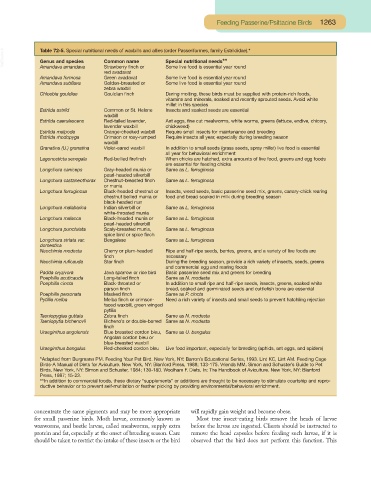Page 1213 - Small Animal Clinical Nutrition 5th Edition
P. 1213
Feeding Passerine/Psittacine Birds 1263
VetBooks.ir Table 72-5. Special nutritional needs of waxbills and allies (order Passeriformes, family Estrildidae).*
Special nutritional needs**
Genus and species
Common name
Amandava amandava
Strawberry finch or
red avadavat Some live food is essential year round
Amandava formosa Green avadavat Some live food is essential year round
Amandava subflava Golden-breasted or Some live food is essential year round
zebra waxbill
Chloebia gouldiae Gouldian finch During molting, these birds must be supplied with protein-rich foods,
vitamins and minerals, soaked and recently sprouted seeds. Avoid white
millet in this species
Estrilda astrild Common or St. Helene Insects and soaked seeds are essential
waxbill
Estrilda caerulescens Red-tailed lavender, Ant eggs, fine cut mealworms, white worms, greens (lettuce, endive, chicory,
lavender waxbill chickweed)
Estrilda melpoda Orange-cheeked waxbill Require small insects for maintenance and breeding
Estrilda rhodopyga Crimson or rosy-rumped Require insects all year, especially during breeding season
waxbill
Granatina (U.) granatina Violet-eared waxbill In addition to small seeds (grass seeds, spray millet) live food is essential
all year for behavioral enrichment
Lagonosticta senegala Red-bellied firefinch When chicks are hatched, extra amounts of live food, greens and egg foods
are essential for feeding chicks
Longchura caniceps Gray-headed munia or Same as L. ferruginosa
pearl-headed silverbill
Longchura castaneothorax Chestnut-breasted finch Same as L. ferruginosa
or munia
Longchura ferruginosa Black-headed chestnut or Insects, weed seeds, basic passerine seed mix, greens, canary-chick rearing
chestnut bellied munia or food and bread soaked in milk during breeding season
black-headed nun
Longchura malabarica Indian silverbill or Same as L. ferruginosa
white-throated munia
Longchura malacca Black-headed munia or Same as L. ferruginosa
pearl-headed silverbill
Longchura punctulata Scaly-breasted munia, Same as L. ferruginosa
spice bird or spice finch
Longchura striata var. Bengalese Same as L. ferruginosa
domestica
Neochimia modesta Cherry or plum-headed Ripe and half-ripe seeds, berries, greens, and a variety of live foods are
finch necessary
Neochimia ruficauda Star finch During the breeding season, provide a rich variety of insects, seeds, greens
and commercial egg and rearing foods
Padda oryzivora Java sparrow or rice bird Basic passerine seed mix and greens for breeding
Poephilia acuticauda Long-tailed finch Same as N. modesta
Poephilia cincta Black-throated or In addition to small ripe and half-ripe seeds, insects, greens, soaked white
parson finch bread, soaked and germinated seeds and cuttlefish bone are essential
Poephilia personata Masked finch Same as P. cincta
Pytillia melba Melba finch or crimson- Need a rich variety of insects and small seeds to prevent hatchling rejection
faced waxbill, green winged
pytilia
Taeniopygiaa guttata Zebra finch Same as N. modesta
Taeniopytia bichenovii Bicheno’s or double-barred Same as N. modesta
finch
Uraeginthus angolensis Blue breasted cordon bleu, Same as U. bengalus
Angolan cordon bleu or
blue-breasted waxbill
Uraeginthus bengalus Red-cheeked cordon bleu Live food important, especially for breeding (aphids, ant eggs, and spiders)
*Adapted from Burgmann PM. Feeding Your Pet Bird. New York, NY: Barron’s Educational Series, 1993. Lint KC, Lint AM. Feeding Cage
Birds-A Manual of Diets for Aviculture. New York, NY: Blanford Press, 1988; 133-175. Vriends MM. Simon and Schuster’s Guide to Pet
Birds. New York, NY: Simon and Schuster, 1984; 130-180. Woolham F. Diets. In: The Handbook of Aviculture. New York, NY: Blanford
Press, 1987; 15-23.
** In addition to commercial foods, these dietary “supplements” or additions are thought to be necessary to stimulate courtship and repro-
ductive behavior or to prevent self-mutilation or feather picking by providing environmental/behavioral enrichment.
concentrate the same pigments and may be more appropriate will rapidly gain weight and become obese.
for small passerine birds. Moth larvae, commonly known as Most true insect-eating birds remove the heads of larvae
waxworms, and beetle larvae, called mealworms, supply extra before the larvae are ingested. Clients should be instructed to
protein and fat, especially at the onset of breeding season. Care remove the head capsules before feeding such larvae, if it is
should be taken to restrict the intake of these insects or the bird observed that the bird does not perform this function. This

